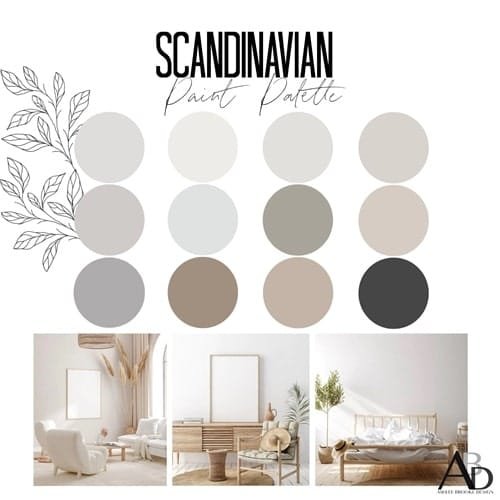When you’re updating your living room, picking the right color palette is essential for building a modern, welcoming vibe.
Today’s color schemes bring together a mix of stylish, cozy elements, using shades that go from soft neutrals and earthy tones to bold pops of color that add personality.
Whether you’re after a minimalist feel, a warm and earthy atmosphere, or a vibrant, eclectic look, knowing the latest color trends can help you create a living room that feels fresh, stylish, and totally unique to you.
This guide covers popular color choices and tips on how to make them work in your space.
Modern Palette Colors for Living Room in Renovations
Updating your living room can make a huge difference in modernizing your home. And color? It’s a game-changer! The right colors set the mood, build the style, and make the space feel like it’s yours—warm, welcoming, and perfectly you.

Today’s modern color palettes mix classic shades with fresh, contemporary tones for living rooms.
This gives you plenty of options to make your space feel light and airy, stylish and sophisticated, cozy, or full of energy—all by playing with color.
Modern living room colors go beyond looks; they’re chosen to shape how the space actually feels.
Neutrals add elegance, bold shades bring excitement, and earthy colors create a grounding, comforting vibe.
From minimalist looks to colorful, lively mixes, each style brings something special to a room.
This article dives into each approach, exploring how different colors influence the feel and look of your living space.
Understanding Modern Palette Color Psychology in Living Rooms
Color psychology in home design highlights how different colors can impact emotions and set a mood. This is especially important in living rooms—the heart of the home where people unwind, socialize, and spend time together. Neutrals can bring a sense of calm, warm shades add coziness, and cool colors create a modern, peaceful atmosphere.

Neutral Tones for Modern Living Room: Calm Yet Elegant Color Choices
Neutral colors like beige, greige, and cream are top picks for a relaxed, welcoming vibe.
These colors offer a simple, uncluttered look that doesn’t overwhelm the space.
Beige adds warmth without being too bright, while greige (a blend of gray and beige) strikes a cozy yet polished balance.
Soft creams and taupes blend easily with accent colors, giving neutrals versatility and a timeless feel.
Warm Colors in Living Room: Building a Cozy, Inviting Ambiance
Warm colors like soft yellows, oranges, and browns make a living room feel friendly and cozy.
These shades add warmth and enhance that comfy feeling, especially in spaces with lots of natural light.
Warm tones also bring out the beauty of wooden elements and work well with darker or neutral accents, making them popular for family rooms and open living areas.
Cool Shades of Color: Boosting Sophistication and Calm in Your Living Room
Cool tones, like soft blues and gentle greens, create a peaceful, modern vibe in a living room.
These shades look especially fresh and airy in rooms with natural light, promoting a serene, open feel.
Cool tones complement sleek, modern decor and add elegance to a space without feeling too cold.
Minimalist Color Palettes for a Sleek Living Room Design
Minimalist color palettes are known for their simplicity, allowing a room’s design elements to take center stage without overwhelming the senses. With minimalism, less is more—each color is chosen thoughtfully to create a calm, balanced atmosphere. Using understated shades, minimalist color schemes focus on neutrals and soft hues that open up spaces and create an airy, cohesive feel.

Modern Soft Greys and Off-Whites for a Balanced Living Room Look
Soft greys and off-whites are a classic minimalist pairing that brings a sense of harmony to any living room.
Off-whites brighten the living room space without the starkness of pure white, while soft greys add subtle contrast, grounding the room with a modern yet inviting feel.
This combination offers a clean, polished look that makes a room feel expansive and uncluttered, ideal for creating a peaceful, relaxing environment.
To enhance the visual appeal of this palette, different textures—like woven rugs, linen fabrics, or stone accents—can be added for depth without introducing more colors.
Simple, streamlined furniture in muted tones blends seamlessly with grey and off-white, while metallic accents like brushed silver or chrome bring a refined touch.
This palette’s elegance lies in its simplicity, allowing the room’s decor and layout to be the focal point.
Greige Modern Color: The Perfect Neutral for Modern Minimalism
Greige, a blend of grey and beige, is an ideal color for minimalist design due to its warmth and versatility.
It combines the sleekness of grey with the comforting warmth of beige, creating a neutral background that complements a wide variety of decor styles.
Greige’s subtle warmth adds depth and coziness to a space, making it perfect for a modern minimalist living room that feels inviting yet uncluttered.
With greige, furniture in darker shades of grey, charcoal, or soft browns can add gentle contrast, creating a harmonious, layered look.
Adding natural elements, such as wood or stone, enhances greige’s organic feel, while accents in black or white provide a striking yet minimalist touch.
Greige is especially effective in rooms with plenty of natural light, which highlights its warm undertones, making the living room feel both open and cozy.
Pale Blues and Greens for a Fresh, Airy Living Room Feel
Pale blues and greens add a soft, refreshing quality to a minimalist living room, bringing in subtle color while maintaining a sleek, understated look.
Light blue evokes feelings of calm and openness, reminiscent of the sky or sea, while pale green adds a touch of natural serenity.
Together, they create a peaceful ambiance that feels both clean and uplifting, ideal for a modern living room with a minimalist approach.
These cool, soft shades pair well with light wood furniture and decor, adding warmth without disturbing the airy feel of the room.
Simple white or beige accents can be introduced for additional brightness, while adding natural materials like linen or jute gives texture and keeps the room feeling relaxed and grounded.
Metallics in brushed silver or soft gold add sophistication to the blue and green tones, creating a refined, calming space that feels both spacious and inviting.
Bold Accent Colors for Statement Living Rooms
Bringing bold accent colors into a modern living room can add excitement and personality. These colors, often featured on walls, furniture, or decorative pieces, help create focal points that make the room unforgettable
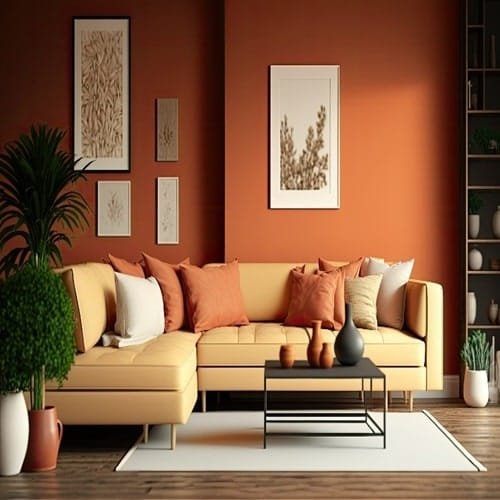
Deep Navy and Rich Emerald Color Palette for Depth and Luxury Living Room
Jewel tones like navy and emerald green add depth and a luxurious vibe.
These colors are bold yet elegant, making them perfect for accent walls or statement furniture.
Navy pairs well with whites and light greys, giving a polished look, while emerald brings vibrancy and a touch of elegance.
Burnt Orange and Mustard Yellow for Vintage Warmth
Burnt orange and mustard yellow add warmth and a retro charm to a room.
These colors make a statement without overpowering, and they work wonderfully with neutral tones.
Burnt orange offers an earthy feel, while mustard yellow adds a playful pop.
Burgundy and Charcoal Colors for Modern Living Room Elegance
For a more sophisticated look, deep burgundy and charcoal create a rich, dramatic color combo.
These shades add depth and pair well with soft greys and warm whites, bringing a modern and chic feel to any living room.
Earthy Tones for a Nature-Inspired Living Space
Earthy tones bring warmth and a grounded feel to a living room, creating a connection with nature that’s both relaxing and inviting. These shades really shine in spaces with natural light, complementing plants, wood accents, and other organic touches.
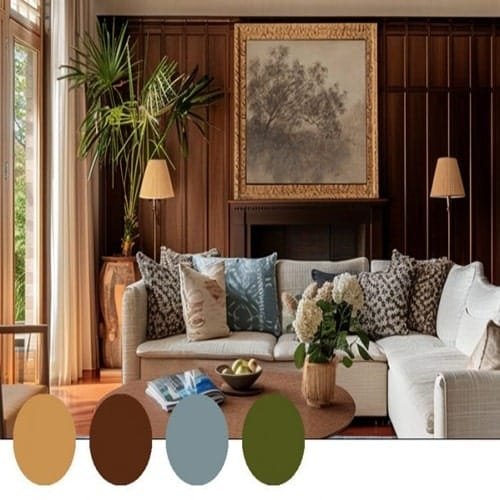
Rust and Terracotta Living Room Colors for Modern Earthy Warmth
Rust and terracotta add warmth and a rustic feel, making the room cozy and welcoming.
These colors pair well with natural materials, like wood and stone, creating a harmonious, down-to-earth vibe that invites relaxation.
Olive Green and Forest Green Living Room Colors for Natural Calm
Greens like olive and forest green bring a calm, serene feel that’s perfect for a nature-inspired living room.
These shades work beautifully with wooden accents, creating a peaceful, outdoor-inspired ambiance that’s refreshing and grounding.
Mocha Browns Colors for a Down-to-Earth Modern Vibe in Every Living Room
Rich mocha and other warm browns add depth, anchoring the room with a natural, comforting presence.
These versatile shades complement various textures and materials, tying together the elements in an earthy, cohesive way that feels effortlessly stylish.
Monochromatic Color Schemes for a Contemporary Living Room
Monochromatic color schemes, which use different shades, tones, and tints of a single color, bring an elegant, cohesive look to modern living rooms. By focusing on variations within one color family, these schemes add depth and dimension while keeping the space unified. Monochromatic palettes are versatile and sophisticated, making them ideal for everything from minimalist to more intricate styles.
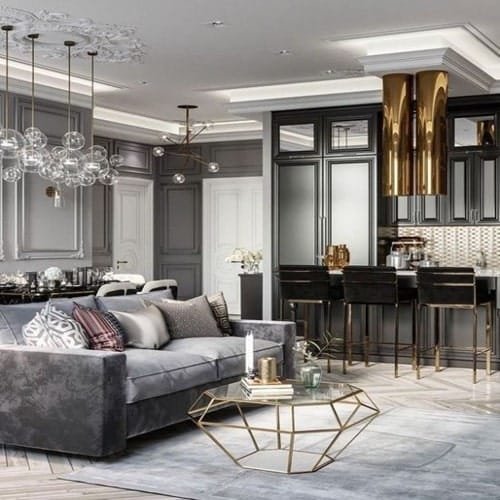
Classic Black and White Colors for a Timeless Living Room Style
A black-and-white palette combines bold contrast with timeless elegance, making a powerful visual impact.
White provides a crisp, clean base, while black adds drama and depth, achieving a sleek, balanced look.
To keep the space from feeling too stark, you can introduce softer elements like textured fabrics, warm lighting, and wooden accents, which add warmth to the scheme.
Furniture in shades of grey or with matte finishes blends seamlessly with black and white, enhancing visual flow.
Patterns like stripes or geometric shapes can also work well within this scheme, adding interest without disrupting harmony.
And small decor pieces, such as plants or metallic touches, add vibrancy, keeping the space inviting yet refined.
Shades of Grey Color for a Cohesive, Modern Living Room Look
A grey-based monochromatic scheme creates a cohesive, modern look with a soft yet contemporary vibe.
Grey offers a wide range, of warm to cool tones, allowing for flexibility in setting the room’s mood.
Light greys make a space feel airy and open, while dark greys add coziness and depth.
Layering different grey shades gives the room a textured, luxurious feel without needing additional colors.
Texture plays a crucial role in a grey monochromatic room.
Materials like brushed metal, soft fabrics, and stone add depth without breaking consistency.
You can add warmth with plush throw pillows, cozy blankets, or a textured rug while keeping the modern look intact.
Accents in white or charcoal bring a subtle contrast, enhancing the room’s sophisticated feel while maintaining monochromatic harmony.
Monochromatic Blues for a Cool and Calming Living Room
A blue monochromatic scheme creates a calming, refreshing atmosphere, perfect for a tranquil, oasis-like living room.
Lighter blues evoke openness, reminiscent of the sky or sea, while deeper blues add richness and comfort.
This palette can turn a living room into a peaceful retreat, with light blues on walls or larger furniture pieces to reflect light and expand the room’s feel, and darker blues, like navy or indigo, to anchor the space in accent walls or statement furniture.
Blue monochromatic schemes pair beautifully with natural materials like light wood, wicker, and indoor plants, adding warmth to the cool palette.
Fabrics like velvet or linen complement blue tones, giving the room a cozy touch.
Metallic accents in silver or brushed nickel introduce a modern edge, enhancing the elegance of the unified color scheme.
The result is a relaxing, sophisticated space that feels cohesive and stylish, embodying the elegance of a single color family.
Pastel Hues for a Soft, Modern Living Room Look
Pastel hues are a fantastic choice for creating a soft, modern look that feels light, inviting, and fresh. These gentle colors add personality without overpowering, giving a space a cozy, contemporary vibe. Pastel shades like baby blue, blush pink, mint green, and lavender are perfect for mixing and matching to achieve a playful yet sophisticated style.

Baby Blue and Blush Pink for a Gentle Contrast. Great for Modern Living Room Colors
Baby blue and blush pink make a classic pastel duo that brings a gentle contrast to the living room, creating a cozy, balanced feel.
Baby blue adds a calm, open vibe, ideal for walls to set an airy backdrop, while blush pink warms things up with a playful touch. Together, they create a harmonious, refreshing look that feels effortlessly modern.
This pairing shines with white or light grey furniture, which blends in seamlessly, allowing the pastels to stand out without overwhelming.
Light wood accents, like a coffee table or shelves, complement the warmth of blush pink, while metallics in rose gold or brass add sophistication.
Plush textures like velvet cushions or a cozy rug can add depth and comfort, making the living room a stylish retreat.
Mint Green and Soft Yellow for a Refreshing Color Palette
Mint green and soft yellow introduce a refreshing, nature-inspired feel to the living room.
Mint green brings a gentle touch of freshness, reminiscent of spring, while soft yellow adds a sunny warmth without overpowering.
This duo creates a cheerful, soothing atmosphere, ideal for a room that feels open, bright, and welcoming.
These colors pair beautifully with natural materials like wicker or light wood, enhancing the space’s organic feel. White or pale grey textiles create a clean backdrop that lets the pastels shine without clashing.
Small decor items, like vases or artwork in matching tones, pull the palette together, giving the room a cohesive, polished look that radiates calm and positivity.
Lavender and Light Grey Color for Subtle Living Room Elegance
Lavender and light grey bring a subtle elegance to a living room, creating a calm, sophisticated environment.
Lavender’s cool, soft undertones add a unique pop of color, while light grey balances it with modern appeal.
This pairing is perfect for a minimalist yet colorful look, introducing chic and understated colors.
Lavender works beautifully on an accent wall or in decor pieces like pillows or curtains, adding gentle charm, while light grey sofas or rugs provide a sleek base that grounds the palette.
For added elegance, consider silver or matte black metallic accents, which enhance the modern feel without overpowering the delicate hues.
The result is a stylish, serene living room with a soft, inviting quality that’s both fresh and timeless.
Vibrant and Eclectic Color Combinations for a Creative Living Room
For anyone looking to add a lively, artistic flair to their living room, vibrant and eclectic color combinations can make the space truly pop. This style thrives on an unexpected mix of colors that bring energy, personality, and warmth. By pairing bold shades in unique ways, an eclectic palette adds visual interest, sparks conversation, and creates a fun, contemporary feel.
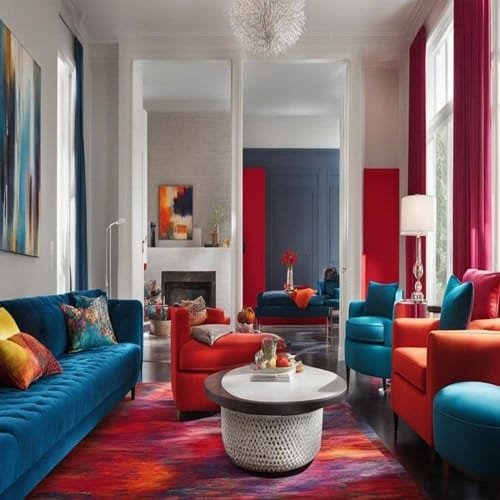
Bright Teals and Turquoises Colors for Bold Living Room Energy
Teal and turquoise infuse a room with bold energy and a hint of tropical zest.
These vibrant shades work well as accent walls or on standout furniture, bringing brightness without overpowering the space. Teal’s rich depth pairs nicely with neutrals like grey or white, keeping the look modern and grounded.
Turquoise, which is slightly brighter and more playful, shines in smaller decor pieces like pillows, rugs, or artwork, adding colorful pops.
This pairing thrives in natural light, which enhances teal and turquoise’s freshness.
To tie the look together, warm metallic accents like gold or brass add elegance, while natural touches—such as woven baskets or wood elements—balance the color’s intensity, resulting in a vibrant yet cozy living room.
Coral and Peach Color for Playful Living Room Vibes
Coral and peach create a warm, cheerful vibe that’s inviting and playful.
Coral, a bright blend of pink and orange, is eye-catching, while peach adds a gentle, cozy warmth.
Used together, they bring an uplifting energy that works in both modern and eclectic spaces.
Coral makes a fantastic accent wall, while peach can add soft undertones in cushions or curtains.
These shades complement neutrals like beige or soft grey, balancing their brightness and keeping the room from feeling too loud.
For added sophistication, metallics like copper or rose gold bring out coral and peach’s warmth.
Greenery also pairs well with this palette, with plants’ natural greens balancing the vibrancy and adding a grounding, organic touch.
Lavender and Soft Pinks for a Fun, Modern Living Room Twist
Lavender and soft pinks offer a fresh, whimsical aesthetic, perfect for a modern yet playful living room.
Lavender’s cool, subdued tone creates a calming backdrop, while soft pinks add warmth and charm for a welcoming atmosphere.
Lavender looks great on walls, while soft pink works well in furniture like sofas or armchairs, providing a cozy counterbalance.
This combination pairs beautifully with matte black or white accents for contrast, adding depth and sophistication.
Pastel decor items, like vases, artwork, or pillows, enhance the space’s dimension without overwhelming the lavender and pink.
Gold accents bring a touch of luxury to the soft palette, resulting in a creative and stylish living room that feels lighthearted and cozy.
Conclusion
Choosing the right color palette for a living room renovation can completely reshape the room’s vibe and functionality. Today’s modern palettes range from minimalistic neutrals to vibrant accents, offering endless possibilities for unique design expression.

Whether you’re looking for a Scandinavian-inspired look, a bold statement, or a nature-infused space, thoughtful color choices and an understanding of color psychology can help create a balanced, beautiful living space that truly reflects your style and personality.
FAQ
What are the best neutral colors for a modern living room?
Beige, greige, and soft grey are top neutral choices, creating a calm and versatile foundation that pairs well with almost any decor.
How can I add bold colors without overwhelming the space?
Incorporate bold shades as accents on feature walls or in statement furniture pieces like sofas and chairs to keep the look vibrant yet balanced.
What colors make a small living room look bigger?
Light neutrals, such as off-whites and soft greys, help open up a room and make it feel more spacious and airy.
Is it okay to mix warm and cool tones?
Yes! Mixing warm and cool tones adds depth and balance to your space, creating a layered and visually interesting look.
How do earthy colors affect the atmosphere?
Earthy tones like terracotta, olive green, and mocha brown bring warmth and grounding energy, connecting the room to nature.
Can dark colors be used in modern living rooms?
Absolutely. Dark shades like navy and charcoal add sophistication and contrast, especially when paired with lighter tones.
What colors work best for a minimalist living room?
Soft neutrals, muted pastels, and greige are ideal for minimalist spaces, creating a clean, serene, and uncluttered look.
![SHEINER CONSTRUCTION – [#1] WHOLE HOUSE REMODELING IN SAN DIEGO & ADU BUILDER](https://sheinerconstruction.com/wp-content/uploads/2024/04/Sheiner-Construction-San-Diego-LOGO.png)
